instrument panel Mercury Marauder 2003 s User Guide
[x] Cancel search | Manufacturer: MERCURY, Model Year: 2003, Model line: Marauder, Model: Mercury Marauder 2003Pages: 232, PDF Size: 2.29 MB
Page 129 of 232
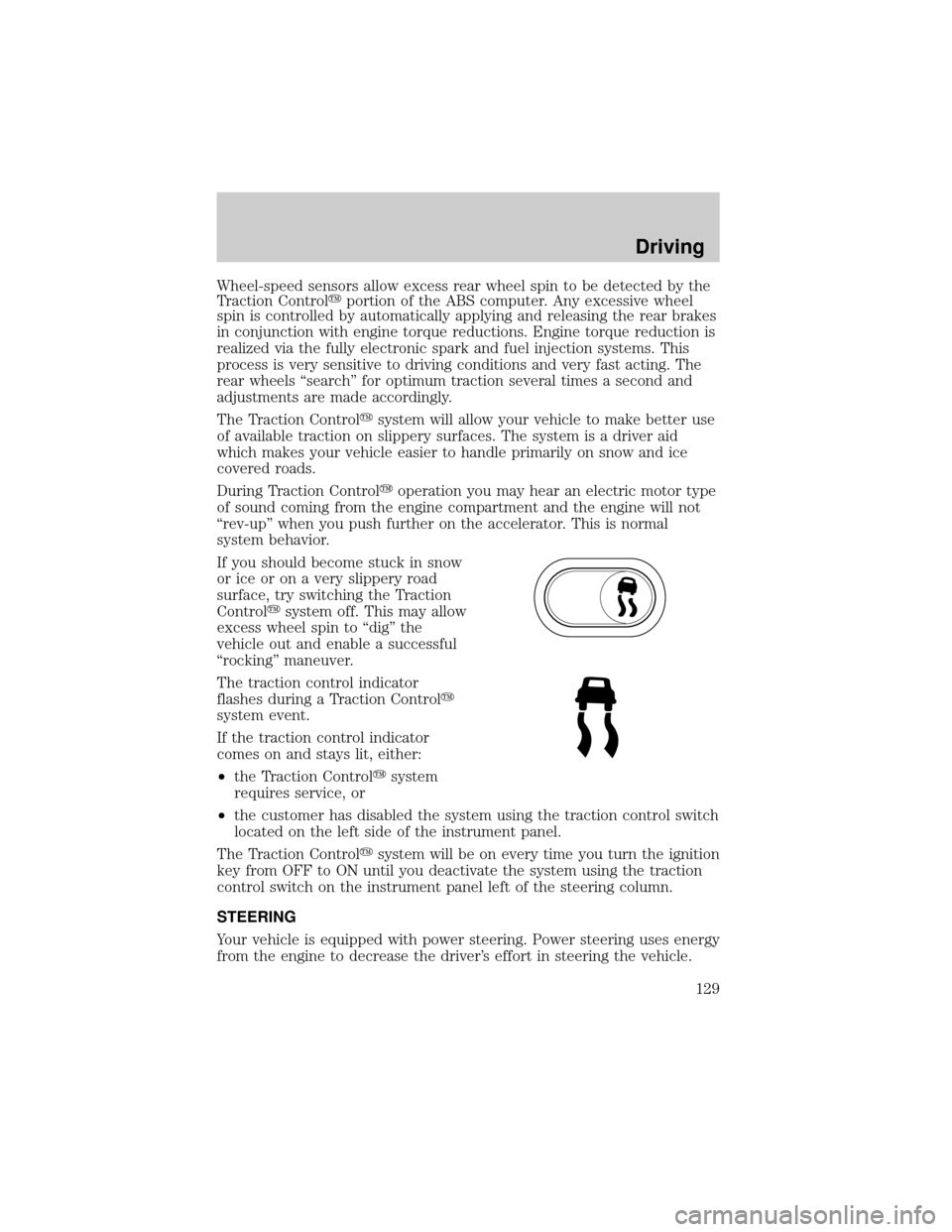
Wheel-speed sensors allow excess rear wheel spin to be detected by the
Traction Controlyportion of the ABS computer. Any excessive wheel
spin is controlled by automatically applying and releasing the rear brakes
in conjunction with engine torque reductions. Engine torque reduction is
realized via the fully electronic spark and fuel injection systems. This
process is very sensitive to driving conditions and very fast acting. The
rear wheels ªsearchº for optimum traction several times a second and
adjustments are made accordingly.
The Traction Controlysystem will allow your vehicle to make better use
of available traction on slippery surfaces. The system is a driver aid
which makes your vehicle easier to handle primarily on snow and ice
covered roads.
During Traction Controlyoperation you may hear an electric motor type
of sound coming from the engine compartment and the engine will not
ªrev-upº when you push further on the accelerator. This is normal
system behavior.
If you should become stuck in snow
or ice or on a very slippery road
surface, try switching the Traction
Controlysystem off. This may allow
excess wheel spin to ªdigº the
vehicle out and enable a successful
ªrockingº maneuver.
The traction control indicator
flashes during a Traction Controly
system event.
If the traction control indicator
comes on and stays lit, either:
²the Traction Controlysystem
requires service, or
²the customer has disabled the system using the traction control switch
located on the left side of the instrument panel.
The Traction Controlysystem will be on every time you turn the ignition
key from OFF to ON until you deactivate the system using the traction
control switch on the instrument panel left of the steering column.
STEERING
Your vehicle is equipped with power steering. Power steering uses energy
from the engine to decrease the driver's effort in steering the vehicle.
Driving
129
Page 146 of 232
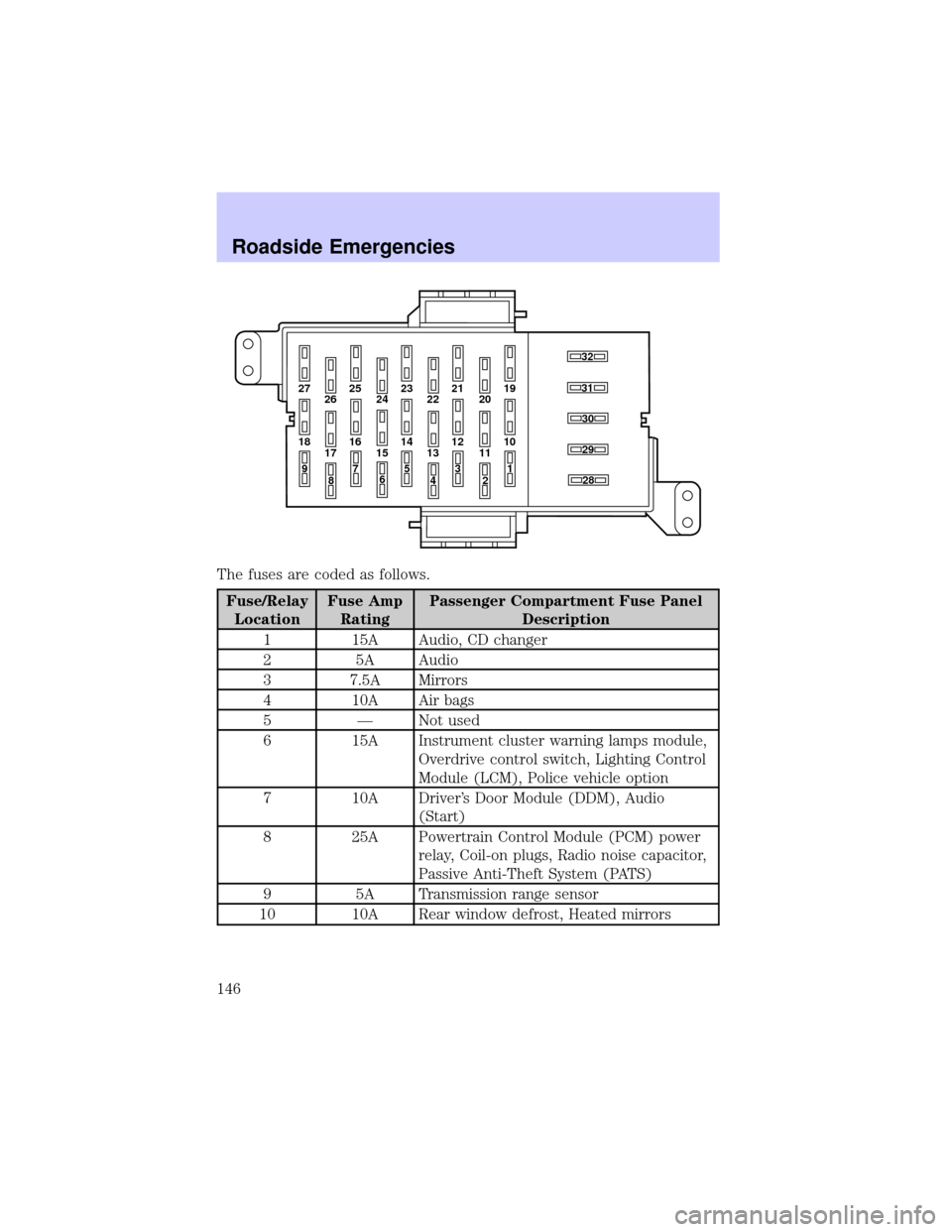
The fuses are coded as follows.
Fuse/Relay
LocationFuse Amp
RatingPassenger Compartment Fuse Panel
Description
1 15A Audio, CD changer
2 5A Audio
3 7.5A Mirrors
4 10A Air bags
5 Ð Not used
6 15A Instrument cluster warning lamps module,
Overdrive control switch, Lighting Control
Module (LCM), Police vehicle option
7 10A Driver's Door Module (DDM), Audio
(Start)
8 25A Powertrain Control Module (PCM) power
relay, Coil-on plugs, Radio noise capacitor,
Passive Anti-Theft System (PATS)
9 5A Transmission range sensor
10 10A Rear window defrost, Heated mirrors
27 25
26 2423 21
2219
20
18 16
17 1514 12
131030
32
31
28
29
11
97
8653
41
2
Roadside Emergencies
146
Page 147 of 232
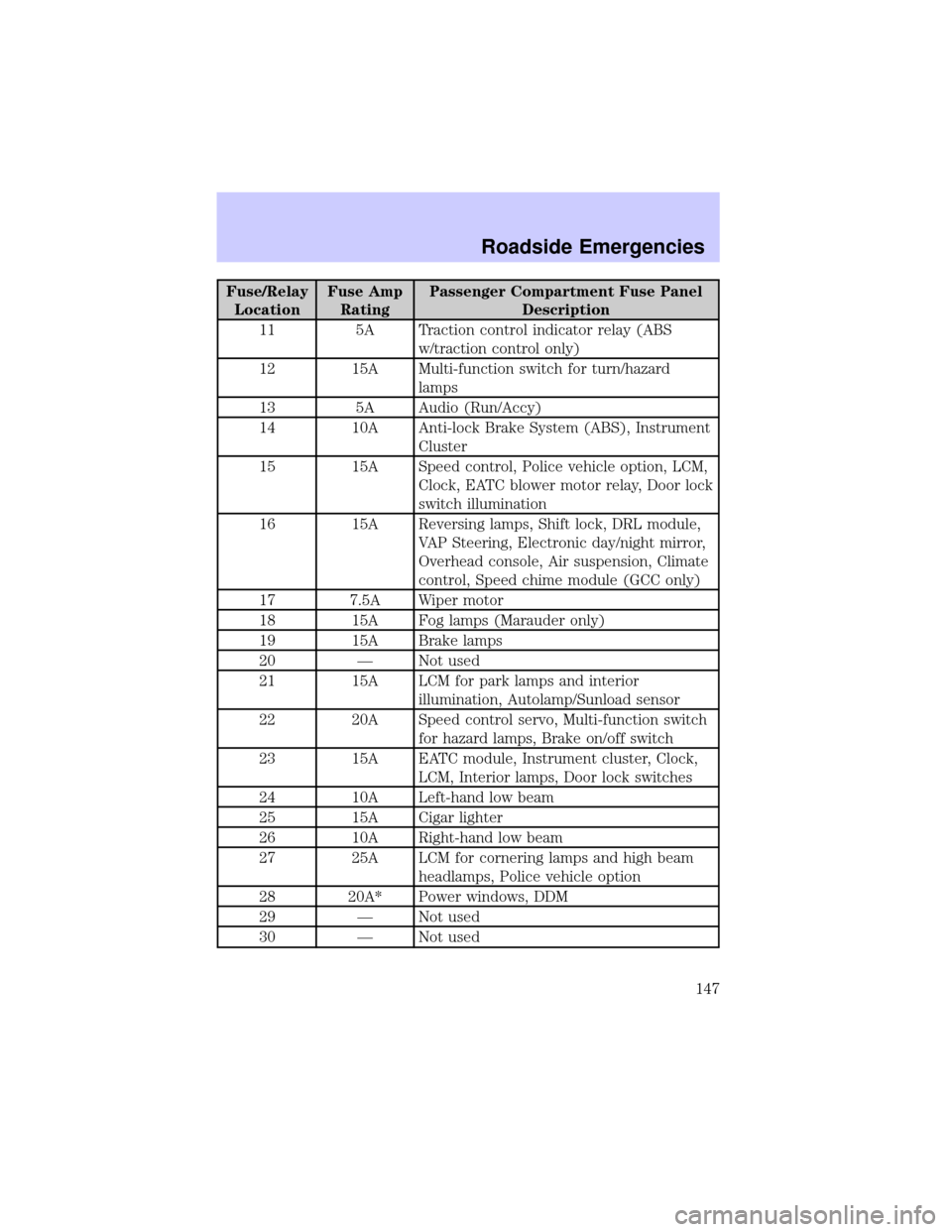
Fuse/Relay
LocationFuse Amp
RatingPassenger Compartment Fuse Panel
Description
11 5A Traction control indicator relay (ABS
w/traction control only)
12 15A Multi-function switch for turn/hazard
lamps
13 5A Audio (Run/Accy)
14 10A Anti-lock Brake System (ABS), Instrument
Cluster
15 15A Speed control, Police vehicle option, LCM,
Clock, EATC blower motor relay, Door lock
switch illumination
16 15A Reversing lamps, Shift lock, DRL module,
VAP Steering, Electronic day/night mirror,
Overhead console, Air suspension, Climate
control, Speed chime module (GCC only)
17 7.5A Wiper motor
18 15A Fog lamps (Marauder only)
19 15A Brake lamps
20 Ð Not used
21 15A LCM for park lamps and interior
illumination, Autolamp/Sunload sensor
22 20A Speed control servo, Multi-function switch
for hazard lamps, Brake on/off switch
23 15A EATC module, Instrument cluster, Clock,
LCM, Interior lamps, Door lock switches
24 10A Left-hand low beam
25 15A Cigar lighter
26 10A Right-hand low beam
27 25A LCM for cornering lamps and high beam
headlamps, Police vehicle option
28 20A* Power windows, DDM
29 Ð Not used
30 Ð Not used
Roadside Emergencies
147
Page 176 of 232

WINDOWS AND WIPER BLADES
The windshield, rear window and wiper blades should be cleaned
regularly. If the wiper does not wipe properly, substances on the
windshield, rear window or the wiper blades may be the cause. These
may include hot wax treatments used by commercial car washes, tree
sap, or other organic contamination. To clean these items, please follow
these tips:
²The windshield or rear window may be cleaned with a non-abrasive
cleaner such as Motorcraft Ultra Clear Spray Glass Cleaner (ZC-23),
available from your dealer.
²Do not use abrasives, as they may cause scratches.
²Do not use fuel, kerosene, or paint thinner to clean any parts.
²Wiper blades can be cleaned with isopropyl (rubbing) alcohol or
windshield washer solution. Be sure to replace wiper blades when they
appear worn or do not function properly.
INSTRUMENT PANEL AND CLUSTER LENS
Clean the instrument panel with a damp cloth, then dry with a dry cloth.
²Avoid cleaners or polish that increase the gloss of the upper portion of
the instrument panel. The dull finish in this area helps protect the
driver from undesirable windshield reflection.
Do not use chemical solvents or strong detergents when cleaning
the steering wheel or instrument panel to avoid contamination of
the air bag system.
²Be certain to wash or wipe your hands clean if you have been in
contact with certain products such as insect repellent and suntan
lotion in order to avoid possible damage to the painted surfaces.
INTERIOR TRIM
²Clean the interior trim areas with a damp cloth, then dry by wiping
with a dry, soft, clean cloth.
²Do not use household or glass cleaners as these may damage the
finish.
Cleaning
176
Page 180 of 232
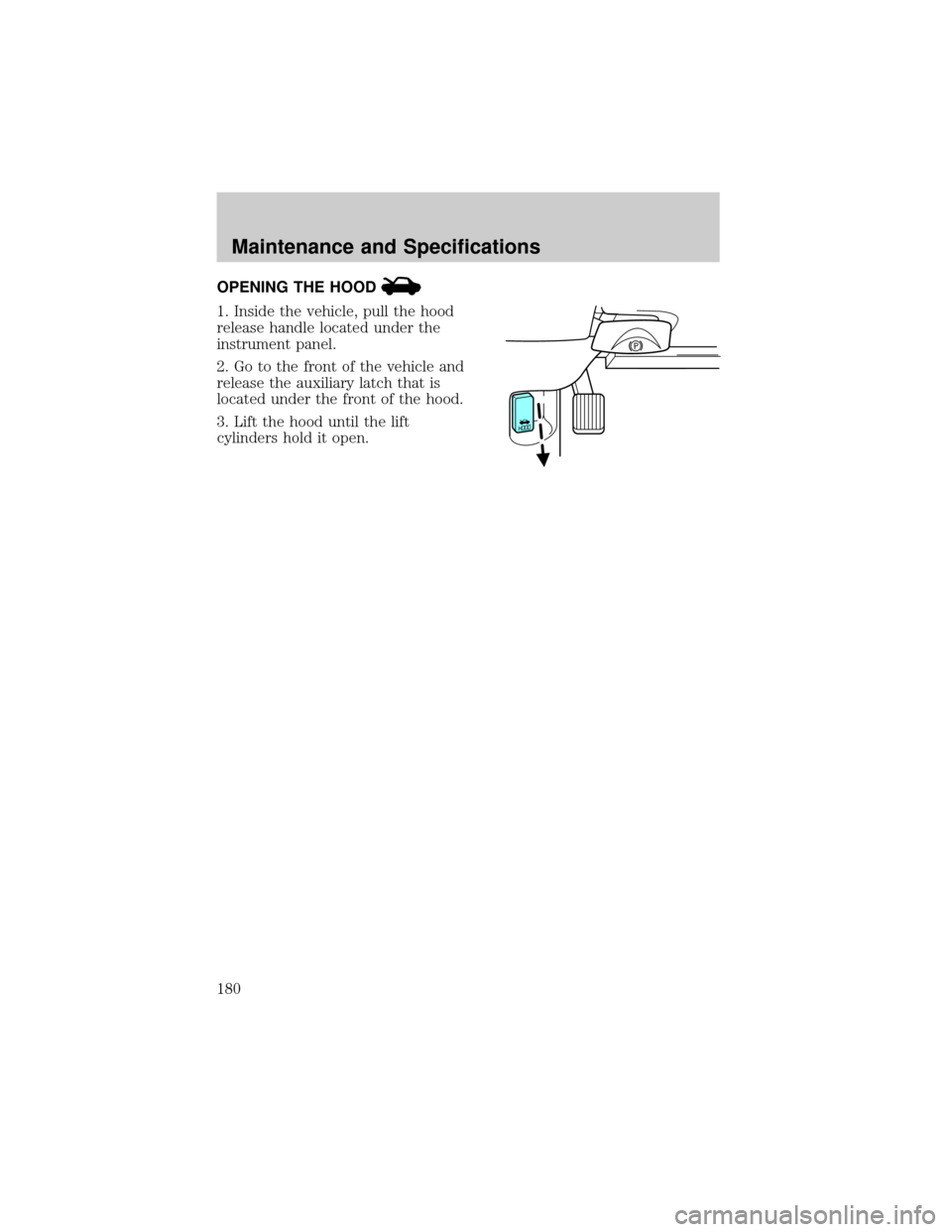
OPENING THE HOOD
1. Inside the vehicle, pull the hood
release handle located under the
instrument panel.
2. Go to the front of the vehicle and
release the auxiliary latch that is
located under the front of the hood.
3. Lift the hood until the lift
cylinders hold it open.
Maintenance and Specifications
180
Page 216 of 232
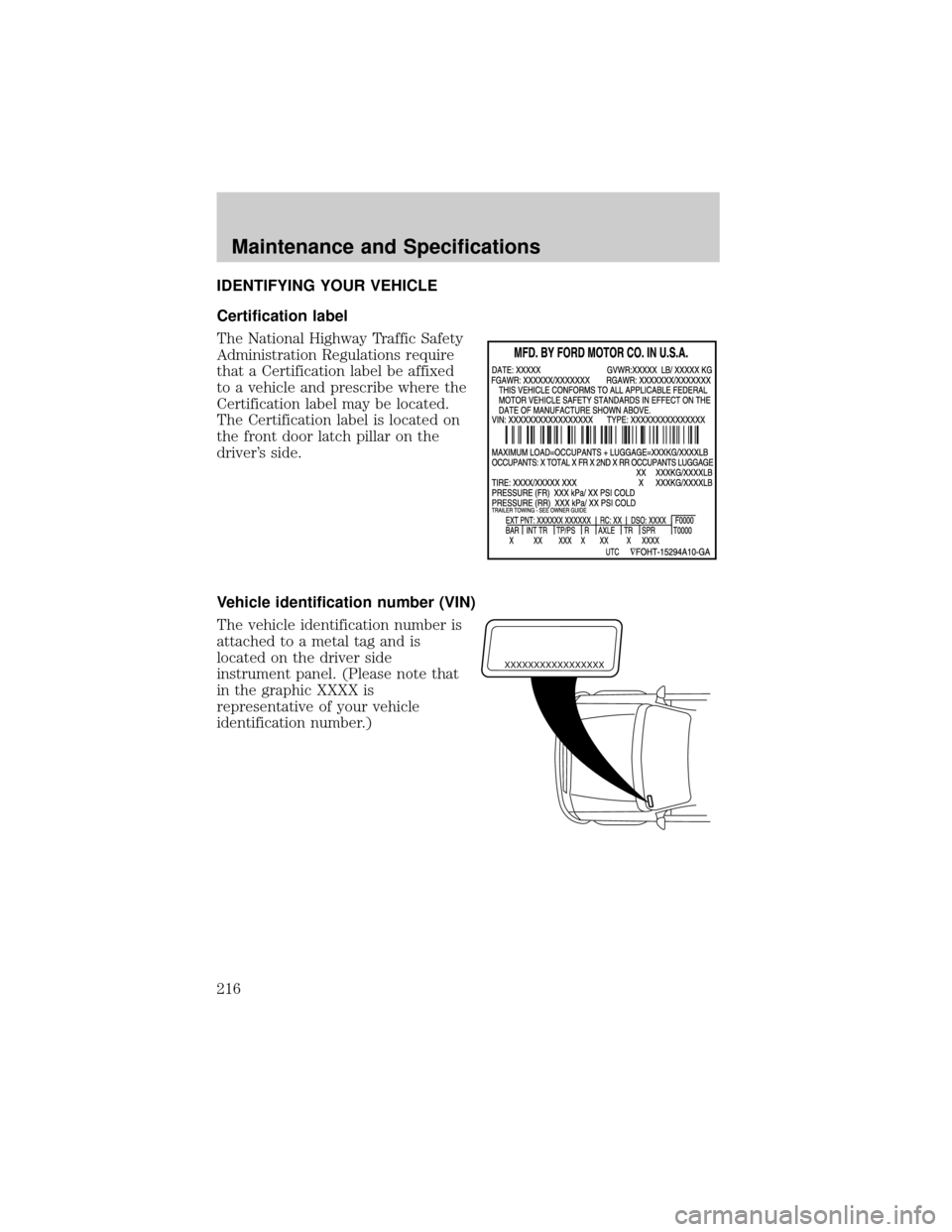
IDENTIFYING YOUR VEHICLE
Certification label
The National Highway Traffic Safety
Administration Regulations require
that a Certification label be affixed
to a vehicle and prescribe where the
Certification label may be located.
The Certification label is located on
the front door latch pillar on the
driver's side.
Vehicle identification number (VIN)
The vehicle identification number is
attached to a metal tag and is
located on the driver side
instrument panel. (Please note that
in the graphic XXXX is
representative of your vehicle
identification number.)
XXXXXXXXXXXXXXXXX
Maintenance and Specifications
216
Page 222 of 232

Child safety seats ......................114
attaching with tether
straps .......................................118
in front seat ............................116
in rear seat ..............................116
Cleaning your vehicle
engine compartment ..............174
instrument panel ....................176
interior .....................................177
interior trim ............................176
plastic parts ............................175
washing ....................................173
waxing .....................................173
wheels ......................................174
wiper blades ............................176
Climate control (see Air
conditioning or Heating) ............33
Clock ............................................24
Compass, electronic
set zone adjustment .................53
Console ........................................74
overhead ..............................51±52
Controls
power seat .................................89
steering column ........................67
Coolant
checking and adding ..............188
coolant temperature light ........13
refill capacities ................193, 211
specifications ..................212, 214
Cruise control
(see Speed control) ....................63
Customer Assistance ................142
Ford accessories for your
vehicle .....................................178
Ford Extended Service
Plan ..........................................165Getting assistance outside
the U.S. and Canada ..............169
Getting roadside assistance ...142
Getting the service you
need .........................................163
Ordering additional owner's
literature .................................170
The Dispute Settlement
Board .......................................166
Utilizing the
Mediation/Arbitration
Program ...................................169
D
Daytime running lamps
(see Lamps) ................................39
Defrost
rear window ..............................37
Dipstick
automatic transmission
fluid ..........................................204
engine oil .................................182
Doors
lubricant specifications ..........212
Driving under special
conditions ..................................135
through water .........................136
E
Emergencies, roadside
jump-starting ..........................156
Emission control system ..........201
Engine ........................................214
check engine/service engine
soon light ..................................10
cleaning ...................................174
coolant .....................................188
Index
222
Page 224 of 232

H
Hazard flashers .........................143
Head restraints ...........................88
Headlamps ...................................38
aiming ........................................40
autolamp system .......................38
bulb specifications ....................43
daytime running lights .............39
flash to pass ..............................40
high beam ...........................14, 39
replacing bulbs .........................44
turning on and off ....................38
warning chime ..........................14
Heating
heating and air conditioning
system .......................................33
HomeLink universal
transceiver (see Garage
door opener) ...................56, 68, 70
Hood ..........................................180
I
Ignition ...............................122, 214
Infant seats
(see Safety seats) .....................114
Inspection/maintenance (I/M)
testing ........................................202
Instrument panel
cleaning ...................................176
cluster ........................................10
lighting up panel and
interior .......................................40
J
Jack ............................................151
positioning ...............................151
storage .....................................151Jump-starting your vehicle ......156
K
Keyless entry system .................82
autolock .....................................81
keypad .......................................82
programming entry code .........83
Keys .......................................84±86
key in ignition chime ...............14
positions of the ignition .........122
L
Lamps
autolamp system .......................38
bulb replacement
specifications chart ..................43
cargo lamps ...............................40
daytime running light ...............39
fog lamps ...................................39
headlamps .................................38
headlamps, flash to pass ..........40
instrument panel, dimming .....40
interior lamps .....................42±43
replacing bulbs ....... 43±45, 47±48
Lane change indicator
(see Turn signal) ........................42
Lights, warning and indicator ....10
air bag ........................................12
air suspension ...........................13
anti-lock brakes (ABS) ....12, 127
brake ..........................................11
charging system ........................12
check engine .............................10
fuel cap light .............................11
high beam .................................14
low coolant ................................13
low fuel ......................................13
overdrive off ..............................13
safety belt .................................12
Index
224